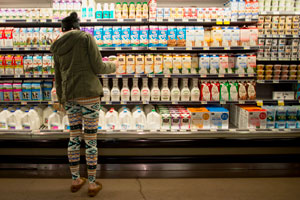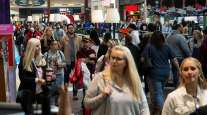Consumer Sentiment Rises in June to Five-Month High

Consumer confidence climbed in June to a five-month high as an improving job market boosted Americans’ attitudes about the world’s largest economy.
The University of Michigan said June 26 that its final index of sentiment increased to 96.1 during the month, exceeding all estimates in a Bloomberg News survey, from 90.7 in May. The median projection of economists polled called for the measure to hold at its preliminary June reading of 94.6.
A stronger job market, near-record stock prices and stabilizing fuel costs are making households more upbeat about their financial situations. Sustained hiring that’s accompanied by faster wage growth would provide an additional boost to consumer spending after a report June 25 showed the biggest gain in purchases since mid-2009.
“Consumer spending will remain the driving force in the economy,” Richard Curtin, director of the Michigan Survey of Consumers, said in a statement. “During the first six months of 2015, consumers more favorably assessed their current finances as well as their future financial prospects than in the first half of any year since 2007.”
The June reading was the second-highest since January 2007. The 5.4-point increase from May was the largest since December 2013. Estimates in the Bloomberg survey of 59 economists for June ranged from 93 to 96.
The survey’s final June index of expectations six months from now increased to 87.8 from 84.2 in May. The preliminary reading was 86.8. The gauge of current conditions, which measures Americans’ views of their personal finances, rose to 108.9 from 100.8 last month. The advance index for June was 106.8.
Americans expected an inflation rate of 2.7% in the next 12 months, down from 2.8% in May, the report showed. Over the next five to 10 years, they also anticipated a 2.6% rate of inflation, matching the lowest since 2002, compared with 2.8% in the previous month.
The Michigan report corroborates the Bloomberg Consumer Comfort Index, which saw a turnaround in sentiment in the past two weeks after dropping almost 8 points from an eight-year high in mid-April. Attitudes about whether it was a good time to spend increased by the most since April 2013.
Improved confidence and more employment opportunities may help explain why consumer spending is perking up. Purchases increased 0.9% in May, the biggest gain since August 2009, Commerce Department figures showed June 25. Retail sales increased 1.2% last month after a 0.2% advance in April.
Payrolls climbed in May by the most in five months, the latest Labor Department data show. Hourly pay increased 2.3% compared with May 2014, at the peak of the narrow range it’s tracked since the end of 2009.
“Consumers reported hearing of fewer recent job losses in June, and the majority of consumers anticipated good times in the economy as a whole during the year ahead,” Curtin said. “When averaged over the first half of 2015, consumers were more likely to expect good times in the economy than in any other year since 2000.”
The Michigan survey showed more Americans in the first half of the year viewed buying conditions as favorable, with attitudes about the purchase of durable goods such as automobiles the brightest since 2007.
“The record levels of buying attitudes have been based on the appeal of low prices and low interest rates without any upward lift from the view that it was better to borrow in advance of expected interest-rate increases,” Curtin said.
Americans also are seeing prices level off at the gas pump. The nationwide average cost of a gallon of gasoline is holding close to $2.80 after advancing about 40 cents a gallon since early April, according to motoring group AAA.
Household spending in the first quarter was a little better than previously reported, making the slowdown in gross domestic product during the three months less daunting than originally estimated. GDP fell at a 0.2% annualized rate in the first quarter, revised from an earlier reading of a 0.7% drop, the Commerce Department said June 24.
In a press conference after the June 17 Federal Open Market Committee meeting, Fed Chair Janet Yellen said she still wants to see more “decisive” evidence of a lasting turnaround in the economy to justify an increase in the benchmark interest rate for the first time since 2006.
In their published economic projections, four policymakers revised their expectations down from two increases this year to just one as the central bankers wait to feel “reasonably confident” that inflation will move back to their 2% target before beginning the rate hike.



